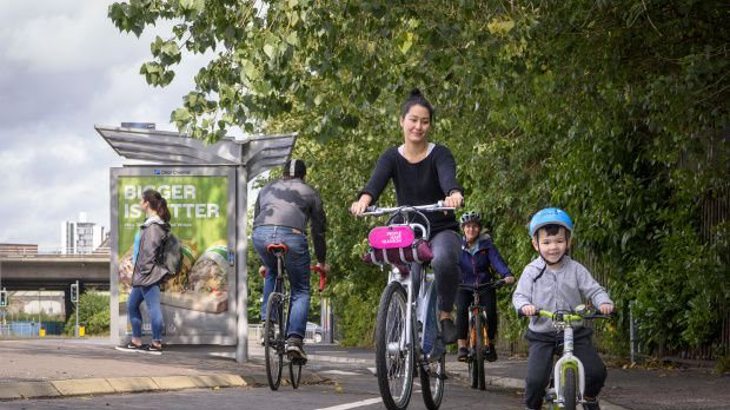New evidence on how walking and cycling can help to reduce congestion offers huge possibilities in terms of turning around transport policy. But effecting this change depends upon embedding evidence-based approaches in transport policy. Andy Cope identifies three of the main constraints that dictate the poor translation of evidence into practice.

This blog summarises Sustrans’ contribution to the conference event Decongesting Europe: New approaches to freeing our cities.
We identify three of the main constraints that dictate the poor translation of evidence into practice as:
- The limitations of cost–benefit analysis mechanisms.
- Too much faith in technological quick-fixes.
- The adherence to predict and provide policies.
The limitations of cost-benefit analysis mechanisms
In theory, UK transport investment decisions are made on the basis of economic appraisal and cost-benefit analysis. Weaknesses in forecasting, disregard for benefit distribution and equity, and the application of dubious techniques (for example, valuing small time savings, and discounting) all bring into question the veracity of an approach that works within the realms of similar projects (for example, comparing one road scheme with another road scheme).
But how does one treat a local walking and cycling network in relation to a road building scheme in this context?
Too much faith in technological quick-fixes
The misplaced optimism in the technological quick-fixes of the future is also an area where huge evidence disconnects can be observed.
A big part of the emphasis on investment in transport research and development is focussed on, for example:
- Electric vehicles – without recognition that on the one hand carbon emissions from energy generation are displaced (from the tailpipe to the power station chimney) rather than eliminated, and on the other hand 45% of particulate matter from traffic comes from brake and tyre wear (as distinct from fuel combustion), so poor air quality remains an issue.
- Autonomous vehicles – despite the lack of any evidence about either consumer demand or the impact on traffic patterns.
- Mobility-as-a-service (MASS) provision – with scant regard for the fact that for many companies entering the market are doing so with the object of consumer data harvesting, rather than through any concern about mobility and accessibility.
The adherence to predict and provide policies
The adherence to predict-and-provide policies means that we look at past travel demand patterns, and we assume that the future will need ‘more of that’. This disregards any possibility of change, whether it be travel demand management, changing lifestyle patterns (for example, fewer younger people than ever own cars or even driving licenses), or even technological shift.
This disconnect between evidence and policy in transport plays out very emphatically in air quality, where contradictions across policy areas introduce the risk of overall policy failure: pollution policies are not effectively integrated; transport policies either disregard air quality implications or are too heavily focussed on distant-future technology-led solutions; and health policies are too heavily focussed on remedial ‘cure’ work, rather than prevention.
The evidence-policy disconnect is reflected in funding decisions like the £15 billion Road Investment Strategy in England, whilst local streets receive very little funding for infrastructure that makes them better spaces for people to use. The current Roads Investment Strategy does not reflect Government policies on environment and public health, does not align with changing societal patterns, and largely ignores the possible future automation of the fleet. And continued investment in road ‘improvement’ does not seem to align well with other aspects of policy on air quality.
Some recent examples of policy papers in England that (at least partially) support walking and cycling include the following:
25 Year Environment Plan
- “New homes will be built in a way that … encourages walking and cycling”
- “We will become a world leader in shaping the future of mobility, including the low carbon transport of the future”
Draft National Planning Policy Framework
- “Minimise the number and length of journeys needed for employment, shopping, leisure, education and other activities ... and provide for high-quality walking and cycling networks and supporting facilities”
National Infrastructure Committee Consultation on a National Infrastructure Assessment
- “New public transport, cycling and walking infrastructure is vital to tackling urban congestion and promoting healthy growth”
- “We need to invest more in alternatives to the private car, upgrading and expanding rail and metro systems, better facilities for cycling and walking and improved bus networks”
And the latest Chief Medical Officer’s report, ‘Health Impacts of all pollution – what do we know’
- “Encouraging greener transport choices will be effective with further infrastructure development and information campaigns, for instance, to improve public perceptions around the safety of cycling in urban areas”
So there are some grounds for optimism, in so far as the evidence of benefits of walking and cycling is feeding into policy. But now policy needs to be reflected in investment decisions. This starts with resolving the current contradictions in investment decisions.
Dr Andy Cope presented this material at the conference 'Decongesting Europe: New approaches to freeing our cities' taking place in Brussels 13-14 March 2018, showcasing the findings of the TRACE and FLOW projects.

